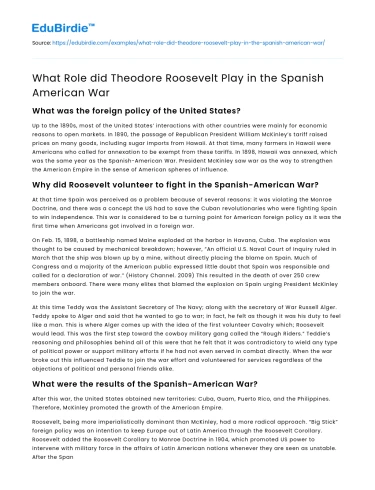What was the foreign policy of the United States?
Up to the 1890s, most of the United States’ interactions with other countries were mainly for economic reasons to open markets. In 1890, the passage of Republican President William McKinley’s tariff raised prices on many goods, including sugar imports from Hawaii. At that time, many farmers in Hawaii were Americans who called for annexation to be exempt from these tariffs. In 1898, Hawaii was annexed, which was the same year as the Spanish-American War. President McKinley saw war as the way to strengthen the American Empire in the sense of American spheres of influence.
Why did Roosevelt volunteer to fight in the Spanish-American War?
At that time Spain was perceived as a problem because of several reasons: it was violating the Monroe Doctrine, and there was a concept the US had to save the Cuban revolutionaries who were fighting Spain to win independence. This war is considered to be a turning point for American foreign policy as it was the first time when Americans got involved in a foreign war.
Save your time!
We can take care of your essay
- Proper editing and formatting
- Free revision, title page, and bibliography
- Flexible prices and money-back guarantee
On Feb. 15, 1898, a battleship named Maine exploded at the harbor in Havana, Cuba. The explosion was thought to be caused by mechanical breakdown; however, “An official U.S. Naval Court of Inquiry ruled in March that the ship was blown up by a mine, without directly placing the blame on Spain. Much of Congress and a majority of the American public expressed little doubt that Spain was responsible and called for a declaration of war.” (History Channel. 2009) This resulted in the death of over 250 crew members onboard. There were many elites that blamed the explosion on Spain urging President McKinley to join the war.
At this time Teddy was the Assistant Secretary of The Navy; along with the secretary of War Russell Alger. Teddy spoke to Alger and said that he wanted to go to war; in fact, he felt as though it was his duty to feel like a man. This is where Alger comes up with the idea of the first volunteer Cavalry which; Roosevelt would lead. This was the first step toward the cowboy military gang called the “Rough Riders.” Teddie’s reasoning and philosophies behind all of this were that he felt that it was contradictory to wield any type of political power or support military efforts if he had not even served in combat directly. When the war broke out this influenced Teddie to join the war effort and volunteered for services regardless of the objections of political and personal friends alike.
What were the results of the Spanish-American War?
After this war, the United States obtained new territories: Cuba, Guam, Puerto Rico, and the Philippines. Therefore, McKinley promoted the growth of the American Empire.
Roosevelt, being more imperialistically dominant than McKinley, had a more radical approach. “Big Stick” foreign policy was an intention to keep Europe out of Latin America through the Roosevelt Corollary. Roosevelt added the Roosevelt Corollary to Monroe Doctrine in 1904, which promoted US power to intervene with military force in the affairs of Latin American nations whenever they are seen as unstable. After the Spanish American War, Roosevelt believed that the American Empire needed to build a canal that would cut across Central America to be able to protect both sides, the Pacific and Caribbean. The Panama Canal was beneficial for economic and military reasons: faster travel for trade and ships, and the US could collect taxes on boats that went through this canal.






 Stuck on your essay?
Stuck on your essay?

